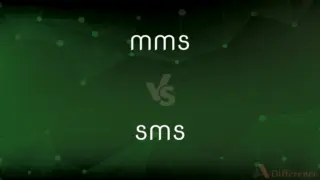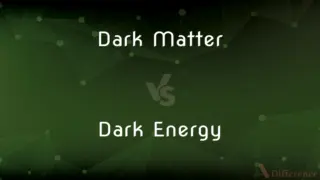Synchronic vs. Diachronic — What's the Difference?
By Tayyaba Rehman & Fiza Rafique — Updated on May 2, 2024
Synchronic analysis studies a language at a specific point in time, focusing on structure, whereas diachronic analysis examines language evolution over time.

Difference Between Synchronic and Diachronic
Table of Contents
ADVERTISEMENT
Key Differences
Synchronic linguistics looks at the structure and usage of a language at a particular moment, often the present. On the other hand, diachronic linguistics explores how languages change over time, tracking developments and transformations.
In synchronic analysis, the focus is on understanding how elements of a language function together at one time without considering historical context. Whereas, diachronic analysis investigates the origins and historical progression of language features, providing insights into why languages are the way they are today.
A synchronic approach might analyze current vocabulary, grammar, and pronunciation in isolation from their historical origins. In contrast, a diachronic approach would trace these elements back through time, identifying how they have evolved due to cultural, social, and technological changes.
Synchronic studies are crucial for creating dictionaries, grammar guides, and language teaching materials that reflect current usage. On the other hand, diachronic studies are invaluable for scholars interested in the history of languages, etymology, and the influence of historical events on language.
The methods of data collection and analysis differ significantly between the two: synchronic linguistics often utilizes current texts and speech samples. Meanwhile, diachronic linguistics relies on historical texts, comparative methods, and reconstruction techniques.
ADVERTISEMENT
Comparison Chart
Focus
Language structure at one point
Language evolution over time
Key Concerns
Current usage and rules
Historical changes and origins
Research Methods
Analysis of contemporary texts
Historical and comparative study
Applications
Language teaching, dictionaries
Etymology, historical linguistics
Example of Study
Modern English syntax
Evolution of English past tenses
Compare with Definitions
Synchronic
Pertaining to one point in time.
A synchronic study of English may focus on contemporary slang.
Diachronic
Pertaining to development over time.
Diachronic studies show how English evolved from Old English.
Synchronic
Analysis of current language.
Linguists perform synchronic analysis to update grammar rules.
Diachronic
Essential for understanding etymology.
Diachronic research clarifies how meanings of words have shifted.
Synchronic
Basis for modern linguistics.
Most modern linguistic theories are developed through synchronic analysis.
Diachronic
Studies linguistic evolution.
Diachronic linguistics reveals the impact of invasions on language development.
Synchronic
Focused on language structure.
Synchronic studies help understand the structure of languages today.
Diachronic
Focus on historical language changes.
Diachronic analysis helps trace the origins of the English language.
Synchronic
Independent of historical context.
Synchronic linguistics ignores the historical development of words.
Diachronic
Involves historical comparison.
Linguists use diachronic methods to compare ancient and modern languages.
Synchronic
Synchronous.
Diachronic
Of or concerned with phenomena, such as linguistic features, as they change through time.
Synchronic
Of or relating to the study of phenomena, such as linguistic features, or of events of a particular time, without reference to their historical context.
Diachronic
Occurring over or changing with time.
Synchronic
Occurring at a specific point in time.
Diachronic
Of, pertaining to or concerned with changes that occur over time.
Synchronic
(linguistics) Relating to the study of a language at only one point in its history.
Diachronic
Used of the study of a phenomenon (especially language) as it changes through time;
Diachronic linguistics
Synchronic
Occurring or existing at the same time or having the same period or phase;
Recovery was synchronous with therapy
A synchronous set of clocks
The synchronous action of a bird's wings in flight
Synchronous oscillations
Synchronic
Concerned with phenomena (especially language) at a particular period without considering historical antecedents;
Synchronic linguistics
Descriptive linguistics
Synchronic
(of taxa) occurring in the same period of geological time
Common Curiosities
How do synchronic and diachronic approaches influence language teaching?
Synchronic approaches help develop materials based on current usage, while diachronic insights can enrich understanding of language history and evolution.
What is the main difference between synchronic and diachronic linguistics?
The main difference is focus: synchronic linguistics studies a language at a specific moment, while diachronic linguistics examines how a language changes over time.
What tools are used in diachronic linguistics?
Diachronic linguistics often uses historical texts, linguistic corpora from different time periods, and comparative analysis.
Why are diachronic studies important in linguistics?
They are crucial for understanding how languages evolve, which can inform theories about human communication and cultural change.
Are there any fields closely related to diachronic linguistics?
Yes, fields like historical linguistics, philology, and etymology are closely related to diachronic linguistics.
How does synchronic analysis benefit everyday language users?
It provides relevant and up-to-date information on language usage, aiding in effective communication.
What can diachronic analysis tell us about a society?
It can reveal how social, economic, and technological changes influence language evolution, reflecting broader societal shifts.
Can synchronic and diachronic analyses be performed on the same language?
Yes, both analyses can be applied to any language, offering different insights into its structure and development.
How do educational institutions use synchronic linguistics?
Institutions use synchronic findings to design language courses and materials that reflect current language usage.
How does one transition from synchronic to diachronic studies?
Scholars often start with synchronic insights and then explore historical texts and data to understand language changes over time.
Share Your Discovery

Previous Comparison
Isomer vs. Epimer
Next Comparison
Calling vs. VocationAuthor Spotlight
Written by
Tayyaba RehmanTayyaba Rehman is a distinguished writer, currently serving as a primary contributor to askdifference.com. As a researcher in semantics and etymology, Tayyaba's passion for the complexity of languages and their distinctions has found a perfect home on the platform. Tayyaba delves into the intricacies of language, distinguishing between commonly confused words and phrases, thereby providing clarity for readers worldwide.
Co-written by
Fiza RafiqueFiza Rafique is a skilled content writer at AskDifference.com, where she meticulously refines and enhances written pieces. Drawing from her vast editorial expertise, Fiza ensures clarity, accuracy, and precision in every article. Passionate about language, she continually seeks to elevate the quality of content for readers worldwide.















































